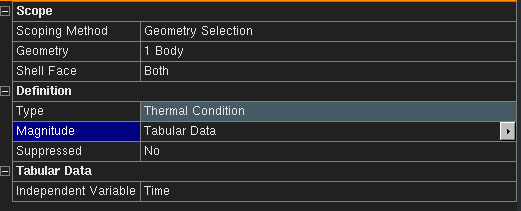TAGGED: transient-structural
-
-
March 31, 2025 at 8:49 am
s224688
SubscriberHello, i have a gemoetry consisting of 4 bodies which in a thermal transient analysis has been cooled down and relevant data from this has been imported as body temperature.
I have a problem where 1 of the bodies are surpossed to start the analysis at -195C however when calculating the deformations i can see that this body has shrunk, which does not make sence since this body is not subject to any temperature change. I believe that the way i define the initial condition of its temperature is wrong. Furthermore the transient structural enviromental temperature is set to -29.4C as this corresponds to another boundary condition.
I use the condition "thermal condition" to define its initial temperature using the "tabular data" magnitude and set the temperature at time = 0, (see picture), to -195C.
To me this seems correct but it does not yeild expected results.
I look forward to hearing from you guys.
Kind regards -Thor
-
March 31, 2025 at 1:48 pm
peteroznewman
SubscriberHello Thor,
Environment temperature sets the zero thermal strain reference temperature for all bodies in the analysis. If one of the bodies needs a different zero thermal strain reference temperature, you can change the reference temperature for that body. Watch this video and at t=9:42 you will see that done. https://www.youtube.com/watch?v=LkMR1hMmbdE
Thermal strain is calculated from the equation CTE*(T(t)-Tref).
The temperature T can be a function of time (t) but Tref is an independently specified input. In your model, Tref for all bodies is the environment temperature of -29.4 C so you get significant shrinkage when you force that body to be at -195 C. If you don’t want shrinkage on that body, in the Geometry branch of the model, click on that one body and in the Details window, on the line for Reference Temperature, change it from By Environment to By Body and then set the value to -195 C. When the temperature of that body is -195 C, there will be zero thermal strain.
-
April 1, 2025 at 2:08 pm
peteroznewman
SubscriberMy response above answers the question you asked. I wonder how you fasten one body at -195C to another body at -29.4 C in a strain-free way? I ask this because that is what you are assuming in the analysis you described.
An assembly process with two parts fastened together at very different temperatures is unusual. One example is freezing a pin and heating a plate with a hole so the pin can be slipped into the hole during assembly, then when the parts return to room temperature, there is an interference fit of the pin in the hole.
Please reply with details on the assembly process for your four body structure and maybe a refinement to the analysis will become apparent.
-
April 1, 2025 at 2:28 pm
s224688
SubscriberHello, first thank you very much for your response. Second the structure is technically starts at 21 degrees and is then the primary part, (lets call it cooling block) of the structure cooled down with liquid nitrogen to -195 degrees. After some time the cooling block stabilizes at -195C and this results in the baseplate of the structure being -29.4C. From this setpoint i need to evaluate deformation and drift within a specified region of the cooling block.
However since i did not notice you writing to me yesterday, I thought a lot about this problem and realized that I need to account for the deformation leading up to the setpoint because of internal stresses.
-
-
- You must be logged in to reply to this topic.



-
3492
-
1057
-
1051
-
965
-
942

© 2025 Copyright ANSYS, Inc. All rights reserved.










